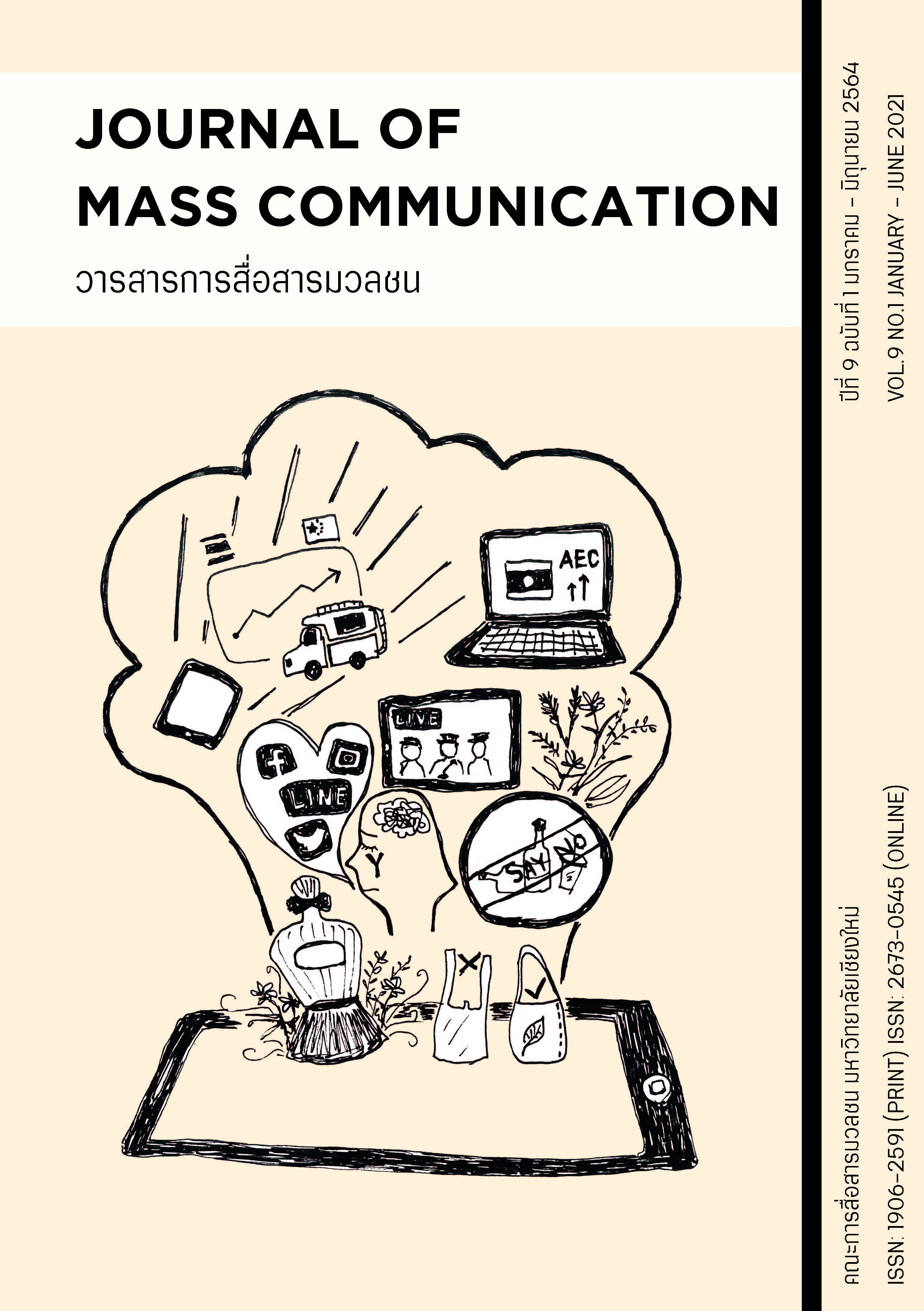Meaning of Scents in the Portrayal of Women to Appears in Perfume Advertising Poster
Main Article Content
Abstract
This qualitative research aimed to study the meaning of scents in the women portrayal of women to appear in perfume advertising poster. Content analysis and review of other related documents were employed as the research tools. The researcher focused on studying women perfume advertising poster reflecting “scents”. There were 6 brands selected as the criteria from perfume posters according to brands concept which were (1) CHANEL, (2) DIOR, (3) YVES SAINT LAURENT, (4) GUCCI, (5) GIORGIO ARMANI, and (6) VERSACE. 3 pictures were selected from each brand making 18 pictures in total. The researcher studied the related documents or articles in several aspects in order to compare the poster analysis data with reality that the brands or the organizations tried to present or communicate. The research was divided into 3 types – (1) brand website (2) documents or articles presenting the information of perfume scents and (3) the data from the informants or perfume counselors at the counter.
The results revealed that the communicative semantic meaning through women portrayal appearing in the perfume advertising poster created the meaning of scents as the women portrayal as the meaning of the real scents through the signifier as the poster and the women characteristics when the communication of women portrayal was through the meaning identification and mutual understanding through the communicative semantic meaning under the social and cultural specification or condition. The illusory creation of perfume meaning might not relate directly to the touch obtained from the scent but through the vision, interpretation of the perfume advertising which was the attempt to communicate the semantic meaning from the sender to the receiver. For the power relation, it was found that what appeared in the poster was from the femininity identified the communicative meaning through scent variable. It was the communication of the presentation on how good scent should be like through their attributes by creating new meaning for the scent to add value and confidence for the women needing the management of getting rid of body odor which was natural. The image variables though the external variable of the women was adjusted to be sexual equal, but there was some mechanic controlling them to retain the femininity.
Article Details

This work is licensed under a Creative Commons Attribution-NonCommercial-NoDerivatives 4.0 International License.
ลิขสิทธ์ที่ผู้เขียนบทความต้องยอมรับ
References
กาญจนา แก้วเทพ และสมสุข หินวิมาน. (2553). สายธารนักคิดทฤษฎีเศรษฐศาสตร์การเมืองกับการสื่อสารศึกษา. (พิมพ์ครั้งที่ 2). กรุงเทพมหานคร: ภาพพิมพ์.
กำจร หลุยยะพงศ์. (2539). การวิเคราะห์เนื้อหาการนำเสนอภาพของความเป็นชายในโฆษณาเบียร์สิงห์. (นิเทศศาสตรมหาบัณฑิต). สาขาการสื่อสารมวลชน, จุฬาลงกรณ์มหาวิทยาลัย.
ทัศนีย์ บุนนาค. (2546). น้ำหอม สุนทรียสื่อสารการตลาด. กรุงเทพมหานคร: Brand Age.
พัชรนันท์ รักตประจิต. (2555). การสื่อสารเรื่องกลิ่นของผลิตภัณฑ์น้ำหอมในโฆษณานิตยสารผู้หญิง. (นิเทศศาสตร์มหาบัณฑิต). สาขาวิชานิเทศศาสตร์, คณะนิเทศศาสตร์, จุฬาลงกรณ์มหาวิทยาลัย.
ภานุพงศ์ จีรกาญจน์. (2556). การสื่อสารตราสินค้ากับการรับรู้คุณค่าตราสินค้าแฟชั่นไทย. (วารสารศาสตรมหาบัณฑิต). สาขาวิชาการจัดการสื่อสารองค์กร, คณะวารสารศาสตร์และสื่อสารมวลชน, มหาวิทยาลัยธรรมศาสตร์.
มหาวิทยาลัยสุโขทัยธรรมาธิราช. (2545). ความรู้เบื้องต้นเกี่ยวกับสื่อสิ่งพิมพ์. (ฉบับปรับปรุงครั้งที่ 1). นนทบุรี: สำนักพิมพ์ของมหาวิทยาลัยสุโขทัยธรรมธิราช
ยุกติ มุกดาวิจิตร. (2541) พิธีกรรมของกลิ่นกาย. ใน ปริตตา เฉลิมเผ่า กออนันตกูล, เผยร่าง-พรางกาย ทดลอง มองร่างกายใน ศาสนา ปรัชญาการเมือง ประวัติศาสตร์ ศิลปะ และมานุษวิทยา. คณะสังคมวิทยาและมานุษยวิทยา, มหาวิทยาลัยธรรมศาสตร์.
สุเทพ จ้อยศรีเกตุ. (2544). การสร้างสรรค์ภาพอุปมาอุปไมยในงานออกแบบโปสเตอร์. (ศิลปกรรมศาสตรมหาบัณฑิต) สาขาวิชานฤมิตศิลป์, จุฬาลงกรณ์มหาวิทยาลัย.
เสาวภา พิณเขียว และ นภวรรณ ตันติเวชกุล. (2560). การสื่อสารความเป็นตราสินค้าระดับโลกและตราสินค้าท้องถิ่นในประเทศไทย. (วารสารบริหารธุรกิจ, เศรษฐศาสตร์และการสื่อสาร. 12(2), 95-96). สืบค้นเมื่อวันที่ 2 มิถุนายน 2563 จาก เว็บไซต์: file:///C:/Users/User/Downloads/69563-Article%20Text-700578-1-10-20190925.pdf
อุ่นใจ เจียมบูรณะกุล. (2549). วาทกรรม “ความสวย” และการต่อรองอัตลักษณ์ วัฒนธรรมบริโภค. (วารสารสังคมศาสตร์ (2), 134-16.4). สืบค้นเมื่อ 24 มีนาคม 2562 จากเว็บไซต์:http://journal.soc.cmu.ac.th/issue_upload/89700%201445849514.pdf

